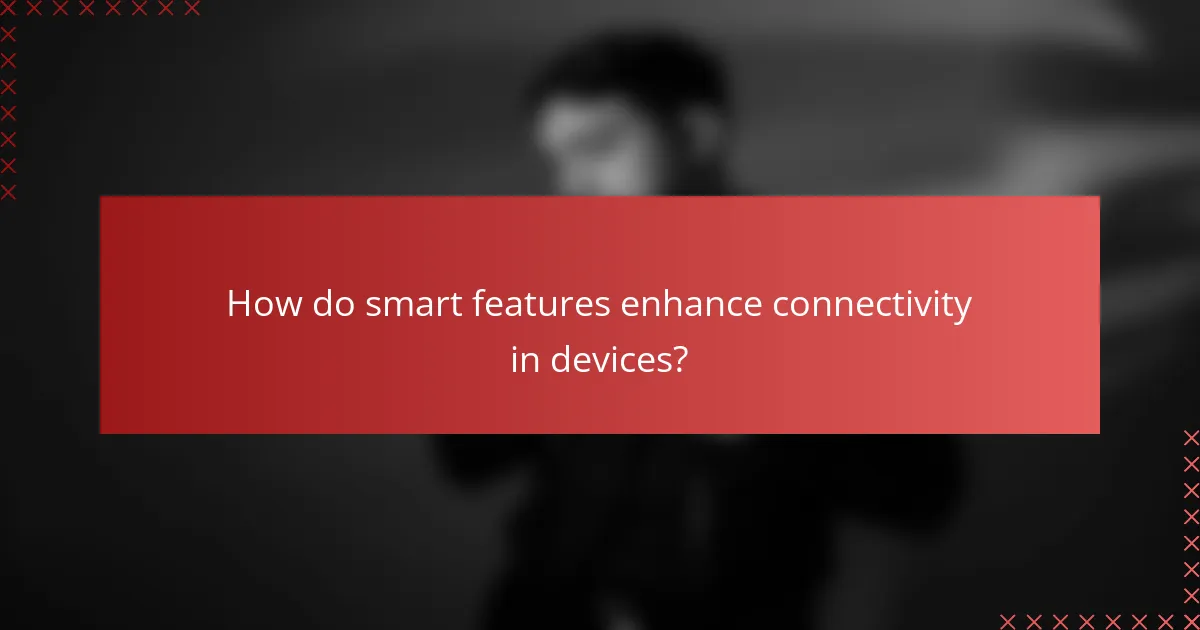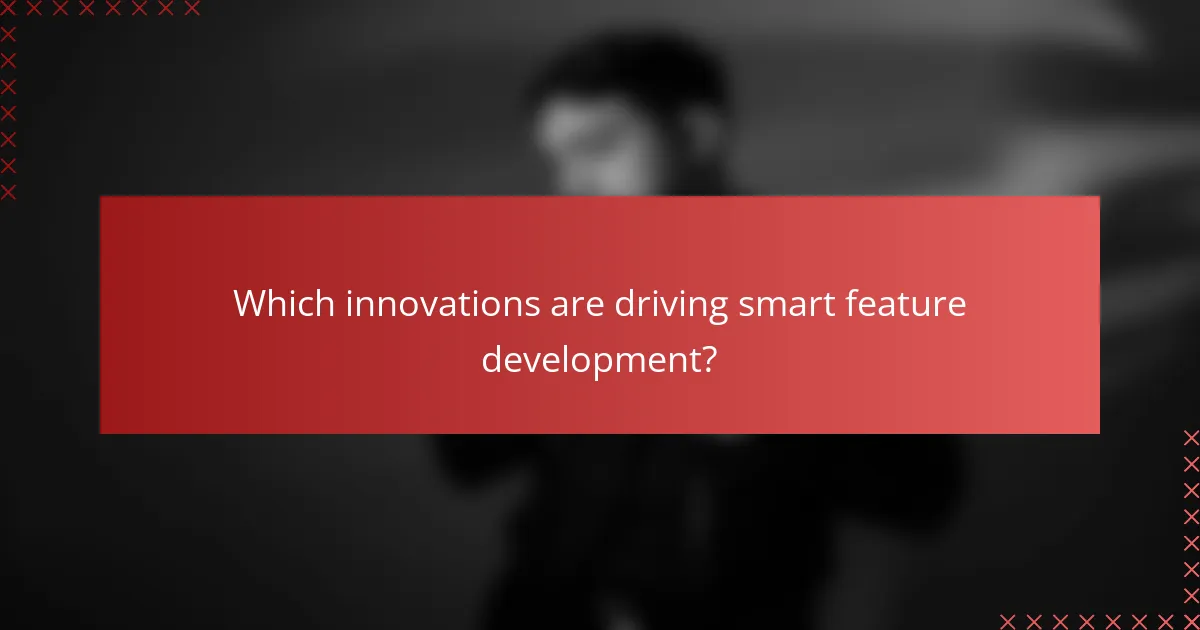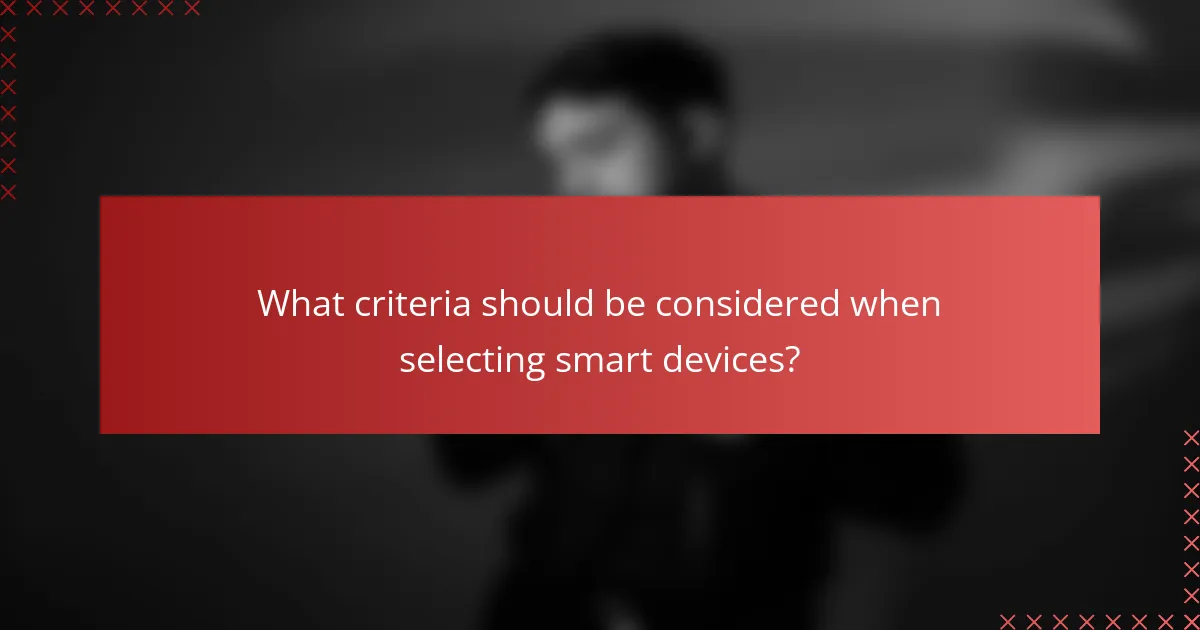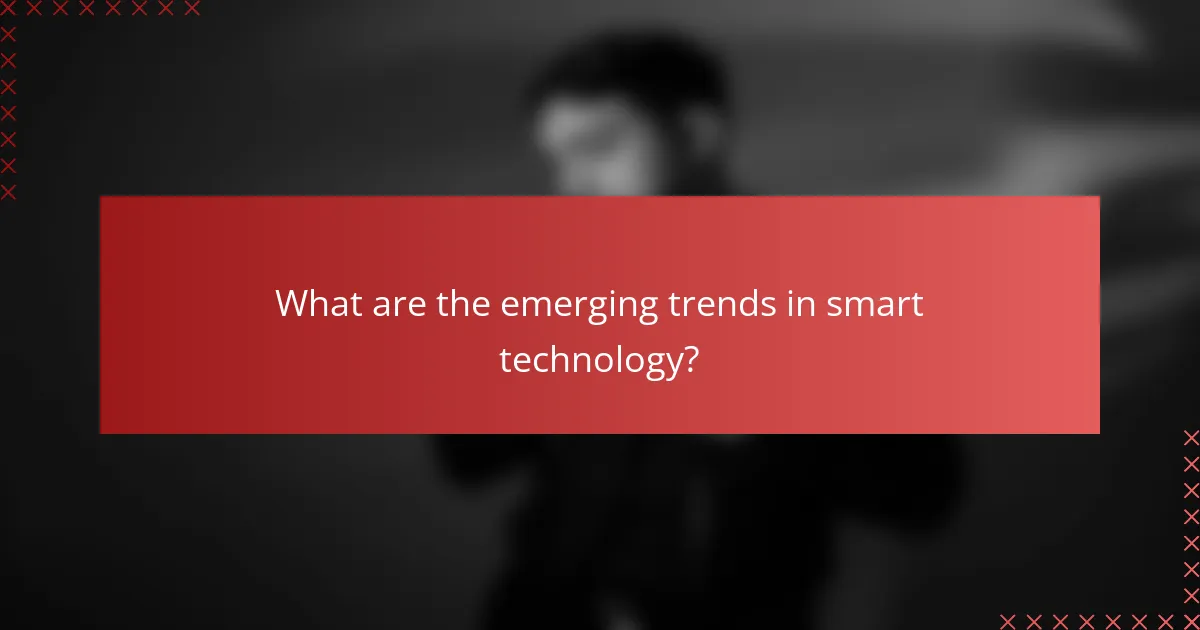Smart features play a crucial role in enhancing connectivity, usability, and innovation across devices. By enabling faster data transfer and seamless integration, these advancements create a more cohesive user experience. Additionally, technologies like artificial intelligence and augmented reality are transforming how users interact with their devices, making interactions more intuitive and efficient.

How do smart features enhance connectivity in devices?
Smart features significantly enhance connectivity in devices by enabling faster data transfer, improved range, and seamless integration with other technologies. These advancements allow devices to communicate more effectively, providing users with a more cohesive and efficient experience.
Wi-Fi 6 technology
Wi-Fi 6, also known as 802.11ax, offers enhanced connectivity by providing faster speeds and better performance in crowded environments. It supports multiple devices simultaneously, making it ideal for homes or offices with numerous connected gadgets.
This technology can deliver speeds up to 9.6 Gbps, significantly reducing latency and improving overall network efficiency. When setting up a Wi-Fi 6 network, ensure your router and devices support this standard to fully benefit from its capabilities.
Bluetooth 5.0 capabilities
Bluetooth 5.0 enhances connectivity by increasing the range and speed of wireless connections between devices. It can transmit data at speeds up to 2 Mbps and has a range of approximately 240 meters in open spaces, making it suitable for various applications, from audio streaming to smart home devices.
When using Bluetooth 5.0, consider the compatibility of your devices to maximize performance. Avoid environments with heavy interference, as this can affect connection stability.
IoT integration
IoT integration allows devices to connect and communicate over the internet, creating a network of smart devices that can work together. This connectivity enables automation and remote control, enhancing user convenience and efficiency.
To effectively integrate IoT devices, ensure they are compatible with common platforms and protocols. Regularly update device firmware to maintain security and performance, and consider using a dedicated hub for better management of multiple devices.

What are the usability benefits of smart features?
Smart features enhance usability by providing intuitive interfaces, seamless connectivity, and innovative functionalities that simplify user interactions. These benefits lead to improved efficiency and a more enjoyable experience across various devices and applications.
User-friendly interfaces
User-friendly interfaces are designed to be intuitive and easy to navigate, allowing users to interact with technology without extensive training. Features such as touchscreens, customizable layouts, and clear icons contribute to a more accessible experience.
For example, smart home devices often utilize simple app interfaces that allow users to control lighting, temperature, and security settings with a few taps. This ease of use can significantly reduce the learning curve for new users.
Voice control functionality
Voice control functionality enables users to operate devices hands-free, enhancing convenience and accessibility. This feature is particularly beneficial for individuals with mobility challenges or those multitasking.
Smart assistants like Amazon Alexa or Google Assistant allow users to issue commands for various tasks, such as playing music, setting reminders, or controlling smart home devices. This functionality can save time and streamline daily routines.
Mobile app compatibility
Mobile app compatibility ensures that smart devices can be controlled remotely via smartphones or tablets, providing flexibility and convenience. Users can monitor and manage their devices from anywhere, enhancing their overall experience.
Many smart devices come with dedicated mobile applications that allow for real-time updates and notifications. For instance, a smart security camera can send alerts to your phone if it detects motion, enabling immediate action regardless of your location.

Which innovations are driving smart feature development?
Innovations such as artificial intelligence, machine learning, and augmented reality are at the forefront of smart feature development. These technologies enhance connectivity, usability, and overall user experience in various applications.
Artificial intelligence applications
Artificial intelligence (AI) applications are transforming how devices interact with users and each other. AI enables smart features like voice recognition, personalized recommendations, and automated responses, making technology more intuitive and user-friendly.
For example, smart home devices use AI to learn user preferences, adjusting settings automatically to enhance comfort and efficiency. When implementing AI, consider the balance between user control and automation to avoid overwhelming users with complexity.
Machine learning algorithms
Machine learning (ML) algorithms analyze data patterns to improve functionality over time. These algorithms can optimize performance by predicting user behavior and adapting features accordingly, which is especially useful in applications like predictive text and smart assistants.
When integrating ML, ensure that the data used is relevant and representative to avoid biases. Regularly updating the algorithms can help maintain accuracy and user satisfaction, as outdated models may lead to poor performance.
Augmented reality integration
Augmented reality (AR) integration enhances user interaction by overlaying digital information in the real world. This technology is particularly impactful in fields such as gaming, education, and retail, where it can provide immersive experiences that engage users more deeply.
For effective AR implementation, focus on user experience by ensuring that the digital overlays are intuitive and do not obstruct essential real-world information. Testing with diverse user groups can help identify potential usability issues before launch.

What criteria should be considered when selecting smart devices?
When selecting smart devices, consider compatibility with existing systems, brand reputation, and the price-to-feature ratio. These factors ensure that the devices not only work well together but also meet your expectations in terms of quality and value.
Compatibility with existing systems
Compatibility is crucial when choosing smart devices, as it determines how well new devices will integrate with your current setup. Check if the devices support common communication protocols like Wi-Fi, Zigbee, or Z-Wave, which can enhance interoperability.
For example, if you already have a smart home hub, ensure that any new devices can connect to it seamlessly. This can save you from the hassle of managing multiple apps and systems.
Brand reputation and reviews
Brand reputation plays a significant role in the reliability and performance of smart devices. Research brands known for quality and customer service, as well as those that frequently update their products with new features.
Reading user reviews can provide insights into real-world performance and potential issues. Look for brands with a strong track record and positive feedback regarding their smart devices to avoid common pitfalls.
Price-to-feature ratio
The price-to-feature ratio helps you assess whether a smart device offers good value for your investment. Compare the features offered by different devices within the same price range to identify which ones provide the most utility.
For instance, a device priced in the mid-range should ideally offer features that justify its cost, such as advanced connectivity options or enhanced security features. Avoid overspending on devices with unnecessary features that won’t enhance your experience.

How do smart features impact user experience?
Smart features significantly enhance user experience by providing tailored interactions, improving accessibility, and delivering timely information. These functionalities create a more engaging and efficient environment for users, making technology more intuitive and responsive to individual needs.
Personalization options
Personalization options allow users to customize their experience based on preferences and behaviors. This can include adjusting settings for notifications, themes, or content recommendations. For example, streaming services often use algorithms to suggest shows based on viewing history, enhancing user satisfaction.
When implementing personalization, consider the balance between user control and automated suggestions. Too many options can overwhelm users, while too few may limit engagement. Aim for a simple interface that allows easy adjustments.
Accessibility features
Accessibility features ensure that technology is usable by individuals with varying abilities. This includes voice commands, screen readers, and adjustable text sizes, which help users navigate devices more easily. For instance, smartphones often come with built-in accessibility settings that cater to users with visual impairments.
When designing for accessibility, adhere to recognized standards such as the Web Content Accessibility Guidelines (WCAG). Regularly test features with real users to identify potential barriers and improve usability for everyone.
Real-time updates and notifications
Real-time updates and notifications keep users informed about important changes or events as they happen. This feature is common in applications like messaging platforms or news apps, where timely information is crucial. For example, a navigation app may provide live traffic updates to help users avoid delays.
To effectively utilize real-time notifications, ensure they are relevant and not overly frequent. Users may become desensitized to alerts if they are too numerous, leading to disengagement. Implement user preferences for notification frequency to enhance the experience.

What are the emerging trends in smart technology?
Emerging trends in smart technology focus on enhanced connectivity, improved usability, and innovative features that streamline user experiences. Key developments include advancements in 5G technology and a heightened emphasis on privacy and security measures.
5G connectivity advancements
5G technology is revolutionizing smart devices by providing faster data transfer rates and lower latency. This enables seamless communication between devices, allowing for real-time interactions and improved performance in applications such as smart home systems and autonomous vehicles.
As 5G networks expand, users can expect enhanced capabilities in smart technology, including higher bandwidth for multiple devices and improved reliability. This shift will support more complex applications, such as augmented reality and high-definition streaming, making smart devices more functional and user-friendly.
Increased focus on privacy and security
With the rise of smart technology, there is a growing concern regarding privacy and security. Manufacturers are increasingly prioritizing the protection of user data, implementing robust encryption methods and secure authentication processes to safeguard personal information.
Consumers should be proactive in understanding the privacy policies of smart devices they use. It’s advisable to regularly update device firmware, utilize strong passwords, and enable two-factor authentication where available. Being informed about potential vulnerabilities can help users make safer choices in their smart technology adoption.
